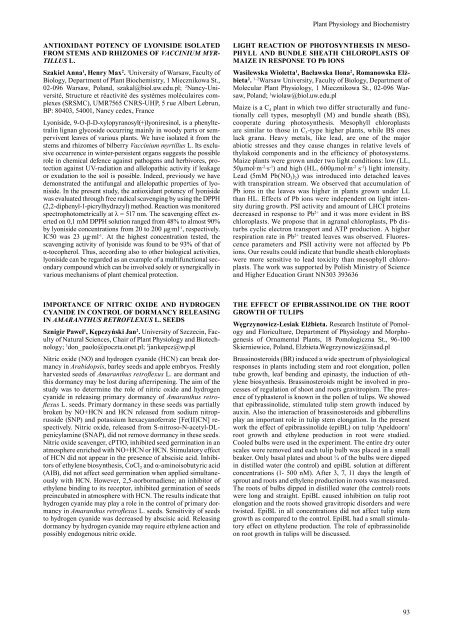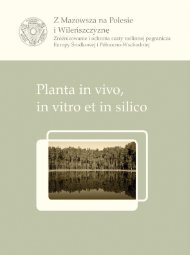acta societatis botanicorum poloniae - LV Zjazd Polskiego ...
acta societatis botanicorum poloniae - LV Zjazd Polskiego ...
acta societatis botanicorum poloniae - LV Zjazd Polskiego ...
You also want an ePaper? Increase the reach of your titles
YUMPU automatically turns print PDFs into web optimized ePapers that Google loves.
ANTIOxIdANT POTENCY OF LYONISIdE ISOLATEd<br />
FrOM STEMS ANd rHIZOMES OF vAccinium myrtillus<br />
L.<br />
Szakiel Anna1 , Henry Max2 . 1University of Warsaw, Faculty of<br />
Biology, Department of Plant Biochemistry, 1 Miecznikowa St.,<br />
02-096 Warsaw, Poland, szakal@biol.uw.edu.pl; 2Nancy-Uni versité, Structure et réactivité des systèmes moléculaires complexes<br />
(SRSMC), UMR7565 CNRS-UHP, 5 rue Albert Lebrun,<br />
BP: 80403, 54001, Nancy cedex, France<br />
Lyoniside, 9-O-β-D-xylopyranosyl(+)lyoniresinol, is a phenyltetralin<br />
lignan glycoside occurring mainly in woody parts or sempervivent<br />
leaves of various plants. We have isolated it from the<br />
stems and rhizomes of bilberry Vaccinium myrtillus L. Its exclusive<br />
occurrence in winter-persistent organs suggests the possible<br />
role in chemical defence against pathogens and herbivores, protection<br />
against UV-radiation and allelopathic activity if leakage<br />
or exudation to the soil is possible. Indeed, previously we have<br />
demonstrated the antifungal and allelopathic properties of lyoniside.<br />
In the present study, the antioxidant potency of lyoniside<br />
was evaluated through free radical scavenging by using the DPPH<br />
(2,2-diphenyl-1-picrylhydrazyl) method. Reaction was monitored<br />
spectrophotometrically at λ = 517 nm. The scavenging effect exerted<br />
on 0,1 mM DPPH solution ranged from 48% to almost 90%<br />
by lyoniside concentrations from 20 to 200 μg∙ml-1 , respectively.<br />
IC50 was 23 μg∙ml-1 . At the highest concentration tested, the<br />
scavenging activity of lyoniside was found to be 93% of that of<br />
α-tocopherol. Thus, according also to other biological activities,<br />
lyoniside can be regarded as an example of a multifunctional secondary<br />
compound which can be involved solely or synergically in<br />
various mechanisms of plant chemical protection.<br />
IMPOrTANCE OF NITrIC OxIdE ANd HYdrOGEN<br />
CYANIdE IN CONTrOL OF dOrMANCY rELEASING<br />
IN AmArAnthus retroflexus L. SEEdS<br />
Sznigir Paweł 1 , Kępczyński Jan 2 . University of Szczecin, Faculty<br />
of Natural Sciences, Chair of Plant Physiology and Biotechnology;<br />
1 don_paolo@poczta.onet.pl; 2 jankepcz@wp.pl<br />
Nitric oxide (NO) and hydrogen cyanide (HCN) can break dormancy<br />
in Arabidopsis, barley seeds and apple embryos. Freshly<br />
harvested seeds of Amaranthus retroflexus L. are dormant and<br />
this dormancy may be lost during afterripening. The aim of the<br />
study was to determine the role of nitric oxide and hydrogen<br />
cyanide in releasing primary dormancy of Amaranthus retroflexus<br />
L. seeds. Primary dormancy in these seeds was partially<br />
broken by NO+HCN and HCN released from sodium nitroprusside<br />
(SNP) and potassium hexacyanoferrate [Fe(II)CN] respectively.<br />
Nitric oxide, released from S-nitroso-N-acetyl-DLpenicylamine<br />
(SNAP), did not remove dormancy in these seeds.<br />
Nitric oxide scavenger, cPTIO, inhibited seed germination in an<br />
atmosphere enriched with NO+HCN or HCN. Stimulatory effect<br />
of HCN did not appear in the presence of abscisic acid. Inhibitors<br />
of ethylene biosynthesis, CoCl 2 and α-aminoisobutyric acid<br />
(AIB), did not affect seed germination when applied simultaneously<br />
with HCN. However, 2,5-norbornadiene; an inhibitor of<br />
ethylene binding to its receptor, inhibited germination of seeds<br />
preincubated in atmosphere with HCN. The results indicate that<br />
hydrogen cyanide may play a role in the control of primary dormancy<br />
in Amaranthus retroflexus L. seeds. Sensitivity of seeds<br />
to hydrogen cyanide was decreased by abscisic acid. Releasing<br />
dormancy by hydrogen cyanide may require ethylene action and<br />
possibly endogenous nitric oxide.<br />
Plant Physiology and Biochemistry<br />
LIGHT rEACTION OF PHOTOSYNTHESIS IN MESO-<br />
PHYLL ANd BUNdLE SHEATH CHLOrOPLASTS OF<br />
MAIZE IN rESPONSE TO Pb IONS<br />
Wasilewska Wioletta 1 , Bacławska Ilona 2 , Romanowska Elżbieta<br />
2 . 1–2 Warsaw University, Faculty of Biology, Department of<br />
Molecular Plant Physiology, 1 Miecznikowa St., 02-096 Warsaw,<br />
Poland; 1 wiolaw@biol.uw.edu.pl<br />
Maize is a C 4 plant in which two differ structurally and functionally<br />
cell types, mesophyll (M) and bundle sheath (BS),<br />
cooperate during photosynthesis. Mesophyll chloroplasts<br />
are similar to those in C 3-type higher plants, while BS ones<br />
lack grana. Heavy metals, like lead, are one of the major<br />
abiotic stresses and they cause changes in relative levels of<br />
thylakoid components and in the efficiency of photosystems.<br />
Maize plants were grown under two light conditions: low (LL,<br />
50µmol∙m -2 ∙s -1 ) and high (HL, 600µmol∙m -2 s -1 ) light intensity.<br />
Lead (5mM Pb(NO 3) 2) was introduced into detached leaves<br />
with transpiration stream. We observed that accumulation of<br />
Pb ions in the leaves was higher in plants grown under LL<br />
than HL. Effects of Pb ions were independent on light intensity<br />
during growth. PSI activity and amount of LHCI proteins<br />
decreased in response to Pb 2+ and it was more evident in BS<br />
chloroplasts. We propose that in agranal chloroplasts, Pb disturbs<br />
cyclic electron transport and ATP production. A higher<br />
respiration rate in Pb 2+ treated leaves was observed. Fluorescence<br />
parameters and PSII activity were not affected by Pb<br />
ions. Our results could indicate that bundle sheath chloroplasts<br />
were more sensitive to lead toxicity than mesophyll chloroplasts.<br />
The work was supported by Polish Ministry of Science<br />
and Higher Education Grant NN303 393636<br />
THE EFFECT OF EPIBrASSINOLIdE ON THE rOOT<br />
GrOWTH OF TULIPS<br />
Węgrzynowicz-Lesiak Elżbieta. Research Institute of Pomology<br />
and Floriculture, Department of Physiology and Morphogenesis<br />
of Ornamental Plants, 18 Pomologiczna St., 96-100<br />
Skierniewice, Poland, Elzbieta.Wegrzynowicz@insad.pl<br />
Brassinosteroids (BR) induced a wide spectrum of physiological<br />
responses in plants including stem and root elongation, pollen<br />
tube growth, leaf bending and epinasty, the induction of ethylene<br />
biosynthesis. Brassinosteroids might be involved in processes<br />
of regulation of shoot and roots gravitropism. The presence<br />
of typhasterol is known in the pollen of tulips. We showed<br />
that epibrassinolide, stimulated tulip stem growth induced by<br />
auxin. Also the interaction of brassinosteroids and gibberellins<br />
play an important role in tulip stem elongation. In the present<br />
work the effect of epibrassinolide (epiBL) on tulip ‘Apeldoorn’<br />
root growth and ethylene production in root were studied.<br />
Cooled bulbs were used in the experiment. The entire dry outer<br />
scales were removed and each tulip bulb was placed in a small<br />
beaker. Only basal plates and about ¼ of the bulbs were dipped<br />
in distilled water (the control) and epiBL solution at different<br />
concentrations (1- 500 nM). After 3, 7, 11 days the length of<br />
sprout and roots and ethylene production in roots was measured.<br />
The roots of bulbs dipped in distilled water (the control) roots<br />
were long and straight. EpiBL caused inhibition on tulip root<br />
elongation and the roots showed gravitropic disorders and were<br />
twisted. EpiBL in all concentrations did not affect tulip stem<br />
growth as compared to the control. EpiBL had a small stimulatory<br />
effect on ethylene production. The role of epibrassinolide<br />
on root growth in tulips will be discussed.<br />
93



